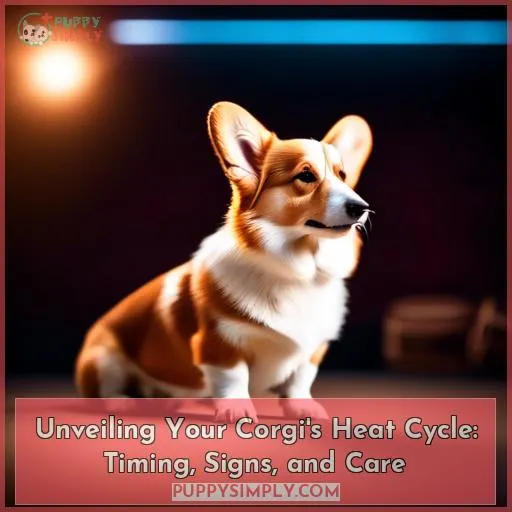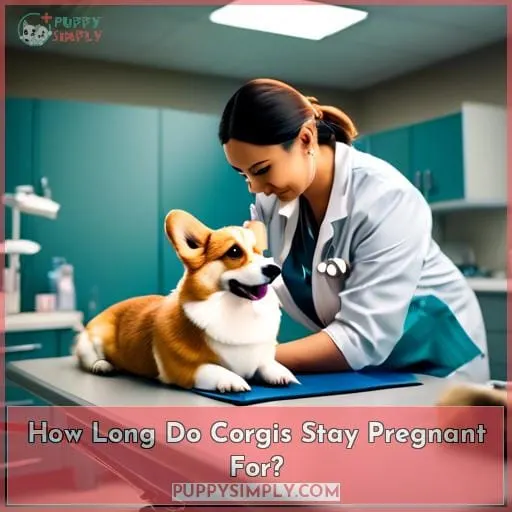This site is supported by our readers. We may earn a commission, at no cost to you, if you purchase through links.
 You’ve been planning and preparing for this moment since your corgi was a puppy.
You’ve been planning and preparing for this moment since your corgi was a puppy.
You’ve read books, talked to your vet, and stocked up on supplies.
You’re ready for your corgi’s first heat.
Or are you?
The truth is, there’s a lot more to a corgi’s heat cycle than most people realize.
In this article, we’ll take a deep dive into the corgi heat cycle, from the first signs to the final stages.
We’ll cover everything you need to know to keep your corgi healthy and happy during this important time.
Table Of Contents
- Key Takeaways
- What is the Corgi Heat Cycle?
- When Do Corgis Go Into Heat?
- How Often Do Corgis Go Into Heat?
- Signs That Your Corgi is Going Into Heat
- Corgi Heat Cycle Stages
- Looking After Your Corgi During Heat
- Should I Wait to Spay/neuter My Corgi Puppy?
- What Age Can Corgis Breed?
- How Many Puppies Do Corgis Have?
- How Long Do Corgis Stay Pregnant For?
- Frequently Asked Questions (FAQs)
- Conclusion
Key Takeaways
- Corgi heat cycles are complex physiological processes that involve hormonal fluctuations.
- Corgis usually go into heat twice a year, with each cycle lasting around 21 days.
- The heat cycle consists of four stages: proestrus, estrus, diestrus, and anestrus.
- Signs of heat in corgis include a swollen vulva, blood spots, bloody discharge, increased urination, and excessive genital grooming.
What is the Corgi Heat Cycle?
Your corgi’s heat cycle, also known as estrous, is a complex physiological process.
It involves hormonal fluctuations that prepare her reproductive system for breeding.
This intricate cycle orchestrates hormonal changes, reproductive readiness, and behavioral fluctuations.
It dictates your corgi’s fertility and heat cycle variations.
Understanding this cycle empowers you with the knowledge to manage your corgi’s fertility effectively, ensuring responsible pet ownership.
When Do Corgis Go Into Heat?
. Typically, 6 to 12 weeks. Typically, 6 to 12 weeks.
How Often Do Corgis Go Into Heat?
Typically, your corgi will grace you with her heat cycle twice a year, approximately every six months.
However, this can vary depending on her age, overall health, and hormonal patterns.
For instance, younger corgis may experience irregular heat cycles, taking longer to establish a consistent pattern.
Conversely, older corgis may experience longer intervals between heats or even skip a cycle altogether.
If you’re contemplating breeding your corgi, understanding her heat cycle is paramount.
Breeding during the estrus stage, which typically occurs 9 to 14 days after the onset of heat, increases the chances of conception.
Keeping track of her cycles will help you understand her reproductive health better and make informed decisions regarding breeding and overall care.
Signs That Your Corgi is Going Into Heat
You can tell your corgi is going into heat by:
- Swollen vulva
- Blood spots
- Discharge
She may also:
- Urinate more often
- Pay extra attention to her genital area
Swollen Vulva
When your corgi goes into heat, you can spot a visibly swollen vulva.
It’s one of the telltale signs that her body is preparing for breeding.
This swelling is a natural response to increased blood flow in the area, which helps support potential pregnancy.
While it’s a normal part of the estrous cycle, it’s essential to be aware of this sign so you can provide appropriate care and prevent unwanted breeding.
Blood Spots
You’ll notice blood spots on your corgi’s bedding and wherever she sits when she’s going into heat.
These spots can be a nuisance, but they’re a natural part of the process.
To keep your home clean, use pet-safe cleaning products to remove the stains.
You can also use hydrogen peroxide to remove blood stains from carpets.
If you’re concerned about the mess, you can consider spaying your corgi to prevent future heat cycles.
Discharge
In the event of estrus, watch out for a bloody, straw-colored discharge from your corgi’s vulva.
This discharge is a sign that your dog’s body is preparing for reproduction.
It may be accompanied by a strong odor, which can attract male dogs.
The discharge may be thick and sticky or thin and watery.
It can also vary in frequency, from a few drops to a steady stream.
Keep your dog clean and comfortable by wiping away the discharge with a damp cloth.
Increased Urination
Upon entering heat, your corgi will likely up her urination frequency.
This increased urination is her body’s way of eliminating excess hormones and toxins.
Keep an eye on her water intake to ensure she stays hydrated, and take her out for frequent potty breaks to avoid accidents.
This is also a good time to train her on outdoor elimination habits.
Paying Extra Attention to Her Genital Area
When your corgi starts paying closer attention to her genitals than usual, you’ll know her heat cycle is about to begin.
She’ll lick, sniff, and groom her vulva excessively, a clear sign that her body is preparing for the upcoming estrus cycle.
This heightened genital grooming is her way of maintaining hygiene and preventing infections during this sensitive time.
Be vigilant about observing these behavioral cues, as they’re crucial in understanding your corgi’s reproductive cycle and taking the necessary preventive measures.
If you notice any unusual discharge or signs of discomfort, don’t hesitate to seek medical attention for your furry friend.
Corgi Heat Cycle Stages
In the various stages of your corgi’s heat cycle, you’ll notice distinct signs and behaviors:
Proestrus:
- She’ll act aggressive toward male dogs.
- She’ll bleed.
Estrus:
- She’ll flirt with male dogs.
- She’ll become receptive to mating.
Diestrus:
- Her body returns to normal if she wasn’t impregnated.
Proestrus Stage
The first stage of your corgi’s heat cycle is called the proestrus stage, a preparatory phase where her body readies for potential pregnancy.
Lasting 7-11 days, this stage is marked by hormonal fluctuations that trigger behavioral changes.
You might notice your corgi becoming more aggressive towards male dogs, tucking her tail, and exhibiting unusual behaviors.
Keep a close eye on her, as the next stage, estrus, is when she’ll be fertile and receptive to mating.
Estrus Stage
During the estrus stage:
- You’ll witness your corgi’s flirtatious behavior with male dogs.
- Her tail will be held to the side, inviting their advances.
- Keep her on a leash during walks to prevent unplanned breeding.
This stage is a crucial time for breeding if that’s your goal.
- Hormonal fluctuations may cause reduced bleeding or discharge.
- Consult your vet if you have concerns about her reproductive health.
Diestrus Stage
You’ll encounter the diestrus stage if your corgi hasn’t been impregnated during estrus.
This stage signifies her body’s shift back to normalcy.
Hormonal changes take a backseat, and her reproductive system rests.
Observe her vulva shrinking, discharge fading, and behavior returning to its usual charm.
This stage lasts about a week, after which she enters anestrus, a non-fertile phase until her next heat cycle.
Consult your vet for breeding plans and spaying options to ensure your corgi’s reproductive health and well-being.
Anestrus Stage
Come full circle into the Anestrus stage, where your corgi’s body resets to a normal rhythm.
This final stage marks a pause in the heat cycle, granting your furry friend a well-deserved break.
No more hormonal surges, no more mood swings, and no more fertility concerns.
It’s a time for her to rejuvenate and regain her usual self.
However, don’t let your guard down just yet.
Regular vet checkups are crucial to ensure her reproductive health remains in tip-top shape.
Looking After Your Corgi During Heat
During your corgi’s heat cycle:
Be patient with her mood swings and unusual behaviors.
Keep her supervised outdoors on a leash to prevent unplanned mating.
Stock up on spare towels and cleaning products to manage any messes.
Be Tolerable of Unusual Behavior and Mood Swings
While your corgi’s in heat, it’s important to be understanding of her unusual behaviors and mood swings.
These are caused by hormonal fluctuations.
This is a time to be patient and provide extra emotional support.
Instead of scolding or punishing her, try using positive reinforcement training techniques to redirect her behavior.
With patience and love, you’ll both get through it together.
Keep Her Supervised Outside (on Leash)
rajut
Spare Towels and Cleaning Products
Spare towels and cleaning supplies will be your allies as you help your corgi through her heat cycle.
Stock up on towels that you don’t mind sacrificing to stains, creating a designated laundry pile for easy washing.
Invest in eco-friendly cleaning products that effectively remove stains and odors without harming your pet or the environment.
Consider Hygiene Pants
Considering hygiene pants can provide your corgi with comfort and prevent messes during her heat cycle.
These pants are designed to absorb discharge and prevent staining of your furniture and carpets.
They also help keep your corgi clean and dry, reducing the risk of infections and other health implications.
Hygiene pants come in various sizes and styles, so you can find the perfect fit for your furry friend.
Wash Her Bed Every Other Day
Wash her bed every other day.
Maintain cleanliness and prevent the spread of stains and odors.
This simple step helps keep her comfortable and your home hygienic.
Regular bedding maintenance shows your corgi you care about her well-being and keeps her from feeling uncomfortable or dirty.
Plus, it prevents lingering heat cycle scents that could attract unwanted male dogs.
Should I Wait to Spay/neuter My Corgi Puppy?
Ask your veterinarian about the right time to spay or neuter your corgi puppy.
Spaying or neutering too early can impede growth and hormonal balance, leading to health implications and behavioral quirks. Conversely, waiting too long can increase the risk of certain cancers and undesirable behaviors.
Seek veterinary guidance to determine the optimal timing for your corgi’s sterilization.
What Age Can Corgis Breed?
Starting at around 6 months of age, your corgi can breed.
However, it’s crucial to understand that this doesn’t mean you should breed your corgi at this age.
Responsible breeding practices dictate waiting until your corgi reaches full maturity, both physically and mentally.
Generally, the ideal breeding age for corgis is between 18 and 24 months.
This period allows your corgi to attain optimal physical and reproductive health, increasing the chances of a successful and healthy pregnancy.
Breeding your corgi too early can result in health complications for both the mother and puppies.
How Many Puppies Do Corgis Have?
Now that you know the age at which Corgis can breed, let’s delve into the adorable world of Corgi puppies!
Picture this: a bundle of fluffy, playful pups scampering around your living room, filling your home with laughter and unconditional love.
The number of puppies a Corgi can have in a single litter varies, adding an element of excitement and anticipation to the breeding process.
A Range of Possibilities:
- Corgi litters typically consist of 3 to 8 puppies, with an average of 5.
-
This range allows for the possibility of a small, cozy litter or a larger, bustling brood.
Factors Influencing Litter Size:
-
Several factors contribute to the size of a Corgi litter, including:
- The age and health of the breeding pair
- The time of year
- the dam’s overall reproductive history
Breeding Considerations:
- Responsible breeding practices prioritize the health and well-being of both the parents and the puppies.
- Before embarking on the breeding journey, ensure that your Corgi is in optimal health, has received appropriate veterinary care, and is free from any genetic or hereditary conditions.
How Long Do Corgis Stay Pregnant For?
Following a successful mating during the estrus stage, your corgi will remain pregnant for approximately 58 to 65 days. This period, known as the gestation period, is crucial for the development of your corgi’s puppies.
Recognizing Pregnancy:
- Keep an eye out for physical changes, such as a swollen abdomen and enlarged nipples, which typically become noticeable around the fourth week of pregnancy.
-
Monitor your corgi’s behavior for signs of nesting, such as gathering blankets and toys to create a comfortable birthing area.
Preparing for Whelping:
- Set up a whelping box, lined with clean towels or blankets, in a quiet and secluded area of your home.
-
Stock up on essential supplies, including puppy formula, heating pads, and a scale to monitor the puppies’ weight.
Postpartum Care:
- After giving birth, your corgi will need plenty of rest and a nutritious diet to regain her strength.
- Keep the whelping area clean and provide fresh water at all times.
- Monitor the puppies for signs of illness or distress, and consult your veterinarian if necessary.
Frequently Asked Questions (FAQs)
Can corgis go into heat twice in a year?
Yes, corgis can experience two heat cycles in a year.
Typically, these cycles occur every six months.
Each cycle lasts approximately three weeks, signaling their readiness for mating and reproduction.
Do corgis experience menopause?
Corgis, like many other canines, don’t experience the hormonal rollercoaster of menopause.
They continue their heat cycles regularly until the twilight of their lives, providing endless opportunities for puppy-filled adventures.
How long does a corgi stay in heat?
A corgi’s heat cycle typically lasts around three weeks.
The fertile period falls within the second week.
Keep a close eye on your furry friend during this time to prevent unwanted pregnancies or infections.
What are the risks of spaying or neutering a corgi too early?
Spaying or neutering too early can stunt growth, increase joint problems, and heighten the risk of certain cancers.
Weigh the pros and cons carefully, consulting your vet to determine the best time for your corgi.
How do I know when my corgi is no longer in heat?
When her tail returns from being tucked between her legs to a natural position,
you can breathe a sigh of relief—your corgi is no longer in heat.
Conclusion
In the tapestry of life, understanding your corgi’s heat cycle is like deciphering an ancient scroll.
It’s a journey filled with unique patterns and rhythms that, when understood, can guide you through this natural process.
Embrace this chapter of your corgi’s life, for it’s a testament to the incredible bond you share.















